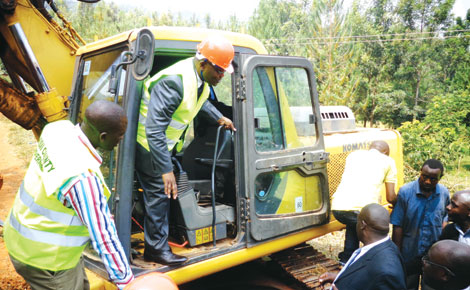 |
|
Kisii Governor James Ongwae (aboard tractor) after he commissioned the construction of 55 roads worth Sh360 million in the county. [PHOTO: FILE/STANDARD] |
Kenya: It is now official – the Kenya Rural Roads Authority (Kerra), Kenya National Highways Authority (KenHa) and Kenya Urban Roads Authority (Kura) will no longer control the management of roads in counties.
This follows a decision to have them remain at national level.
Roads have been classified as either national or county in a move that will render Kerra, KenHa and Kura roles at county level irrelevant.
“We have now classified all roads as either national or county roads. This effectively removes the State organisations (Kura and KenHa) from controlling county roads,” Transition Authority (TA) chairman Kinuthia Wamwangi said.
Kenya’s road network has been established to be 160,886km long. About 61,936km of these roads are classified while the remaining 98,950km are unclassified.
Responsibility for managing the road network falls under the Ministry of Roads and is implemented through KenHa, Kerra, Kura and the Kenya Wildlife Service.
RAGING BATTLE
“The national government will now handle Class A, B and C while county governments will handle Class D, E and unclassified roads, bringing an end to the raging battle for control of the roads function between the two governments,” Wamwangi explained.
He said the decision would be ratified next week and gazetted to avoid further disagreements between the national and county governments over management and funding of roads.
“When the governors met the minister, we resolved to ensure that we handled our own roads.
“We are waiting for TA to have the decision to gazette so that we can identify and map our roads based on the new classifications,” Kakamega Governor Wycliffe Oparanya said.
Oparanya said the road from Sigalagala to Butere, which is Class D, would be surrendered to the State, which had already begun plans to tarmac it.
“We will, however, hand over the Sigalagala-Butere road as it was already planned for under the national government,” Oparanya said.
Scarce funds
The governor said the move would enable the county fit the road system into rational planning and allocation of scarce funds, as a more objective and quantifiable basis is required for prioritising groups of roads unlike before when the State laid claim to some of the roads in the counties, further delaying funding.
Stay informed. Subscribe to our newsletter
The current classification system was developed over 30 years ago and has six classes from A to E, and a class for special purpose roads. Each class is defined by the functional criteria related to the administrative level of centres the roads connect.
Class A covers international trunk roads, including the Northern Corridor that runs through Mombasa-Nairobi-Malaba-Kampala.
Class A roads are link centres of international importance and cross international boundaries or terminate at international ports or airports, which shall remain under the national government.
 The Standard Group Plc is a
multi-media organization with investments in media platforms spanning newspaper
print operations, television, radio broadcasting, digital and online services. The
Standard Group is recognized as a leading multi-media house in Kenya with a key
influence in matters of national and international interest.
The Standard Group Plc is a
multi-media organization with investments in media platforms spanning newspaper
print operations, television, radio broadcasting, digital and online services. The
Standard Group is recognized as a leading multi-media house in Kenya with a key
influence in matters of national and international interest.
 The Standard Group Plc is a
multi-media organization with investments in media platforms spanning newspaper
print operations, television, radio broadcasting, digital and online services. The
Standard Group is recognized as a leading multi-media house in Kenya with a key
influence in matters of national and international interest.
The Standard Group Plc is a
multi-media organization with investments in media platforms spanning newspaper
print operations, television, radio broadcasting, digital and online services. The
Standard Group is recognized as a leading multi-media house in Kenya with a key
influence in matters of national and international interest.









